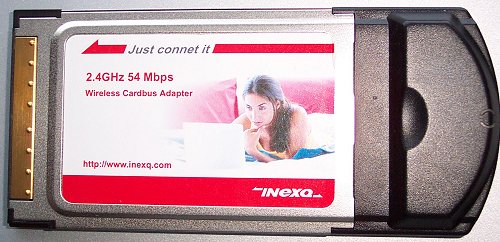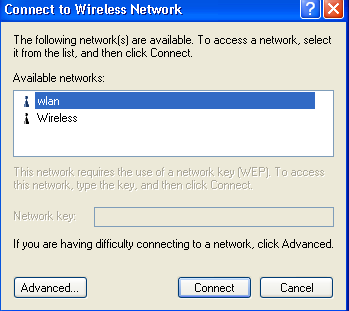54g Cardbus adapter
There's little point in reviewing a 54g Access Point in isolation. iNexQ also bundled in its 54g cardbus PCMCIA-based adapter, aptly named MR054g.
It, naturally, works from the same 2.4GHz radio frequency and has a theoretical throughput of 54Mbps. The bundle, if you'd call it that, comprises of the PCMCIA card, an installation CD that also contains an web-based manual, and a similar multi-language quickstart guide as found on the HR054g.

A close-up shows the pertinent details. The right-hand side contains two status LEDs that flash at various speeds, with each speed denoting connection status. A fast blink infers that a connection has been made and transfers are taking place. The card measures approximately 115mm x 53mm. It contains a raised section on the LED side, which makes it look a little frumpy when compared to some other PCMCIA Wireless cards.

Here it's pictured next to a Buffalo 802.11b AirStation card. The iNexQ isn't a large card by any stretch of the imagination, it's just that it would look a little sexier had it been the Buffalo's size.
The MR054g is supported under Windows 98SE, Windows Millennium, Windows 2000 and Windows XP. However, driver software must be installed prior to card usage, something that's not the case with the Buffalo 802.11b adapter. Driver software installation is as easy as it sounds. Click on setup, answer yes to various screens and reboot once finished. After that, install the card in the host machine, a laptop of some kind, and it should be Wi-Fi ready.
iNexQ bundles in a software utility, under the heading of WLAN Cardbus Adapter Configuration, that provides feedback and some level of user manipulation over settings. Assuming that a Wireless Access Point is place, in range and operating correctly, a link should be established between the card and AP.


2 Wireless connections are shown and wlan, as identified on the AP's settings' screen, is chosen as the desired connection. Incidentally, the other connection is from a Netgear broadband router and combined AP, running via the 802.11b protocol. The link speed and quality is dependant on a number of factors, including distance from AP, number of fixed obstacles between card and AP, and the possible infringement of other radio-based devices in the vicinity of either the adapter or AP. Here, the link is shown to be running at 54Mbps and having excellent signal strength. We'll be looking into performance on the following page.

The configuration program allows one to tweak settings to differing environments. Windows XP ships with a zero-configuration ability that takes the hard work out of connectivity. It also, however, severely limits the usefulness of any configuration software supplied with hardware. Disabling it allows on to create ad-hoc settings for a particular, specialised environment, although we'd be hard pushed to find that kind of situation arising in a home setting.

Once zero-configuration has been disabled in Windows XP, the user is free to set attributes that'll enhance performance in a given situation. As mentioned before, both the AP and card worked correctly with default specifications intact. That's kind of important in this area. Most users are fine when navigating around Windows XP but are decidedly nervous and apprehensive when it comes to setting up home Wireless networks. It sounds complicated, and that's one of the obstacles that firms like iNeXq must overcome. As with most things, a little research and patience pays handsome dividends.
Let's not put both items to the test, which will involve benchmarking performance from various locations.









